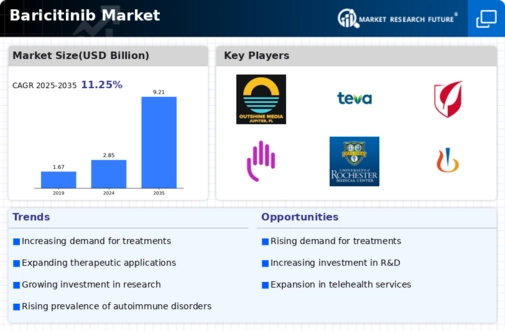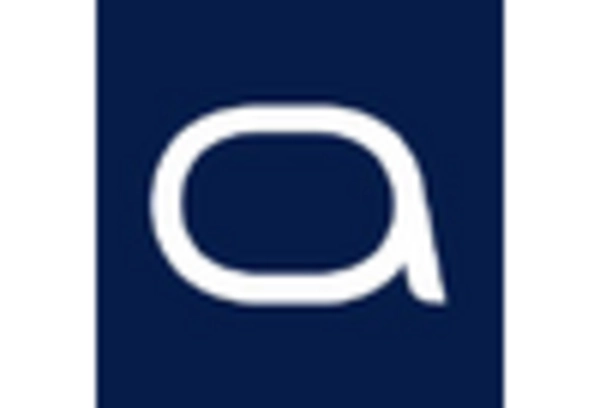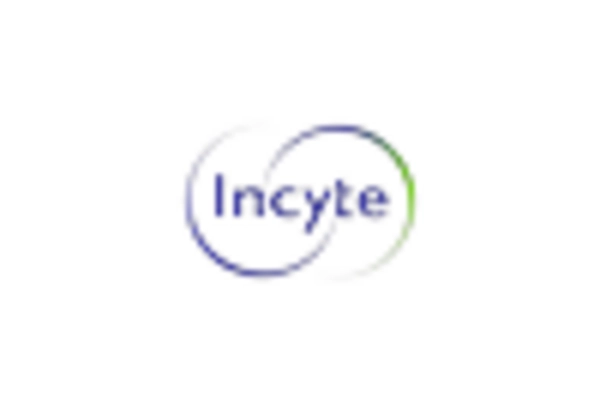Rising Prevalence of Autoimmune Diseases
The increasing incidence of autoimmune diseases, such as rheumatoid arthritis and atopic dermatitis, is a primary driver of the Baricitinib Market. As more individuals are diagnosed with these conditions, the demand for effective treatment options rises. According to recent estimates, autoimmune diseases affect approximately 5-8% of the population, leading to a significant market opportunity for Baricitinib. This medication has shown promise in managing symptoms and improving the quality of life for patients. Consequently, pharmaceutical companies are likely to invest in research and development to expand the therapeutic applications of Baricitinib, thereby enhancing its market presence. The Baricitinib Market is expected to witness substantial growth as healthcare providers increasingly adopt this treatment for various autoimmune disorders.
Advancements in Drug Formulation and Delivery
Innovations in drug formulation and delivery systems are poised to enhance the efficacy and patient compliance of Baricitinib, thereby driving the Baricitinib Market. Recent advancements in nanotechnology and targeted delivery mechanisms may improve the bioavailability of Baricitinib, allowing for lower dosages and reduced side effects. This could potentially lead to a broader acceptance of the drug among healthcare professionals and patients alike. Furthermore, the development of combination therapies that incorporate Baricitinib with other agents may provide synergistic effects, increasing its therapeutic potential. As a result, the Baricitinib Market is likely to experience growth as these advancements are integrated into clinical practice, making the drug more appealing to prescribers and patients.
Increased Investment in Biopharmaceutical Research
The Baricitinib Market is benefiting from heightened investment in biopharmaceutical research and development. Pharmaceutical companies are increasingly allocating resources to explore new indications for Baricitinib, which may lead to expanded market opportunities. The global biopharmaceutical sector has seen a surge in funding, with investments reaching over 200 billion in recent years. This influx of capital is likely to accelerate the pace of clinical trials and regulatory approvals for Baricitinib, facilitating its entry into new therapeutic areas. As research continues to unveil the drug's potential, the Baricitinib Market may witness a significant uptick in demand, driven by both healthcare providers and patients seeking innovative treatment options.
Regulatory Support and Approval for New Indications
Regulatory bodies are increasingly supportive of innovative therapies, which is a crucial driver for the Baricitinib Market. Recent approvals for new indications of Baricitinib have opened avenues for its use in various conditions beyond rheumatoid arthritis. This trend suggests a favorable regulatory environment that encourages pharmaceutical companies to pursue additional clinical trials and submissions for new indications. As regulatory agencies continue to recognize the therapeutic potential of Baricitinib, the market is likely to expand, attracting more investment and interest from stakeholders. The Baricitinib Market stands to benefit from this supportive regulatory landscape, which may facilitate quicker access to treatment for patients in need.
Growing Awareness and Education on Treatment Options
The Baricitinib Market is also influenced by the growing awareness and education surrounding treatment options for autoimmune diseases. As healthcare professionals and patients become more informed about the benefits and risks associated with Baricitinib, the likelihood of its adoption increases. Educational initiatives, including workshops and seminars, are being implemented to disseminate knowledge about the drug's efficacy and safety profile. This heightened awareness may lead to a shift in prescribing patterns, with more healthcare providers considering Baricitinib as a viable treatment option. Consequently, the Baricitinib Market is expected to expand as informed patients advocate for effective therapies, prompting healthcare systems to integrate Baricitinib into their treatment protocols.

















Leave a Comment